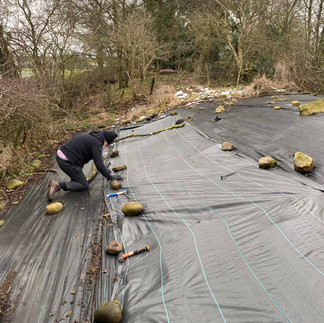An update on Geotextile Trial at Tees Rivers Trust: One of many approach's to tackling Giant hogweed
- Tees Rivers Trust

- Jan 13
- 3 min read
At Tees Rivers Trust, we are constantly exploring new and innovative ways to manage invasive plant species, particularly those that pose a significant threat to local ecosystems. One such plant is Giant Hogweed (Heracleum mantegazzianum), a fast-growing and aggressive species known for its hazardous sap, which can cause severe skin irritation. Tackling this invasive plant requires careful planning and action, and last year, we began an exciting trial using geotextile material to combat its spread (check out our previous posts about it: Post 1 and Post 2)
A Trial Inspired by Success in Estonia
Our approach was inspired by a similar project conducted by the Estonian Environmental Board, who used geotextile fabric to suppress the growth of not only Giant Hogweed but also Japanese knotweed. These materials block sunlight, preventing the plants underneath from photosynthesizing and effectively killing off unwanted vegetation. Recognizing the potential of this technique, we decided to trial it on an area severely affected by Giant Hogweed here in Tees.
Monitoring Progress and Learning Along the Way
We are now nearly 1 year into this geotextile trial, and the results have been promising. By covering the ground with the fabric, we have successfully hindered the growth of Giant Hogweed at most of the site. Regular monitoring allows us to keep a close eye on the area, ensuring that the material is staying in place and that no new plants are pushing through. However, we’ve learned that no method is without its challenges. As the site is located on a windy hill, one section of the geotextile has experienced a small gap. To address this, today, with the help of some dedicated volunteers, we added another sheet of geotextile over the exposed area to prevent any growth from taking hold in the coming season.
Adapting to the Environment

The site is known for its windy conditions, which is one of the challenges we’ve had to work around. In addition to securing the geotextile with pegs, we’ve found that using large rocks and branches—many of which have been washed up by the nearby river—has proven to be an effective and natural way to weigh down the fabric. By adapting to the environment and using the materials available to us, we are confident this method will help keep the fabric in place and provide the necessary barrier against the invasive plants.
Environmental Considerations
While we are excited about the progress we’ve made, we are also mindful of the environmental impact of using geotextile material, which is often made of plastic. It’s important to note that this method was chosen as an alternative to using chemical treatments such as herbicides, which can have long-term environmental consequences. Additionally, once our trial is complete, we plan to reuse the geotextile material, minimising waste and maximising its utility. After a few years, once the invasive species have been successfully controlled, we hope to plant wildflowers in the area, further enhancing the biodiversity of the site.
Continuing the Work
This trial is still very much a learning experience for us. As we continue to monitor the effectiveness of the geotextile and refine our approach, we remain committed to acting while we can to address the issue of invasive species. We understand that each step we take teaches us something new about how best to manage these persistent plants in a way that is both effective and sustainable.
As we move forward, we will continue to share updates on our progress, and we look forward to the day when we can celebrate a site that has been cleared of Giant Hogweed, providing a healthier and more biodiverse environment for both wildlife and the local community.






















Comments